Video Vitals
What Makes the Perfect CTV Commercial?
by The QuickFrame and MNTN Teams9 min read
In partnership with:

Abstract
- QuickFrame’s AI-powered creative analytics tool, Video Vitals, correlated more than 1,800 CTV commercials with their corresponding performance data points enabled through MNTN’s platform.
- Creative attributes (like emotion, topics, and number of talent) were analyzed against their impact on two key metrics—Visit Rate and Conversion Rate (CVR).
- Shorter ads generated higher visit rates; 15 second ads drove 46% higher Visit Rate than 30 second ads.
- 30 second ads are optimal for driving conversions; they produced 24% better conversion performance vs. the overall average CVR.
- Different emotional elements drove different outcomes, and elements’ impact varies depending on industry or vertical.
Table of Contents
- 01 Introduction
- 02 Methodology
- Key Definitions
- 03 Overall Insights
- Length/Duration
- Sentiment/Tone
- Opening Emotion
- Number of Talent
- Percentage of Talent Speaking
- Number of Scenes
- 04 Vertical-Specific Insights
- Beauty & Wellness
- Fashion & Apparel
- Food & Beverage
- Home & Garden
- Travel
Connected TV is the New Normal
In the 1930s, every home had a radio to listen to their favorite programs—sponsored by the biggest advertisers of the time.
By the 1950s, every home had a television to watch their favorite shows—with commercial breaks from industry leaders still in business today.
Over the next decade, every home will have a Connected TV (CTV) to stream their favorite shows and content—featuring your advertisements. Nearly 82% of US households own at least one CTV device, making it one of the fastest growing advertising channels that will continue booming in the coming years.
But the proliferation of CTV is just one reason why the channel is so vital today. Data privacy changes have begun dismantling other digital marketing channels, like dulling the effectiveness of social media to reach target audiences and measure efficacy with precision. By diversifying your media mix to include CTV, you unlock a treasure-trove of information that can help circumvent some of the biggest data-deprecation headaches marketers are experiencing.
The necessity of CTV is a no-brainer. But there’s still an elephant in the room that’s paralyzing marketers from making major moves on the platform. Which type of ads should run on CTV?
It’s a salient question that, historically, marketers didn’t have an answer for. You can easily find hundreds of reports detailing the basic benefits of CTV, but there’s never been a data-driven analysis into what actually drives performance on the platform.
Until now.
MNTN and QuickFrame have come together to deliver this first-of-its kind report, giving the industry a glimpse into the hyper-specific creative elements that lead to the highest—and lowest—performance on CTV.
With an AI-powered tool, we analyzed thousands of commercials to offer a holistic understanding of the creative that is currently grabbing consumer attention. Our research surfaced industry-wide and vertical-specific best practices that marketers should use as a starting point to generate data-backed video creative that can be optimized to boost performance from campaign to campaign.
Methodology
This research utilized the most unique parts of the QuickFrame and MNTN platforms—data-driven creative analytics and performance TV advertising, respectively.
QuickFrame’s AI-powered creative analytics tool, Video Vitals, ingested, digested, and correlated more than 1,800 CTV commercials with their corresponding performance data points enabled through MNTN’s platform.
Next, creative attributes (like emotion, topics, and keywords) were analyzed against their impact on two key metrics—Visit Rate and Conversion Rate (CVR)—to understand the minutiae of what’s driving the highest performance.
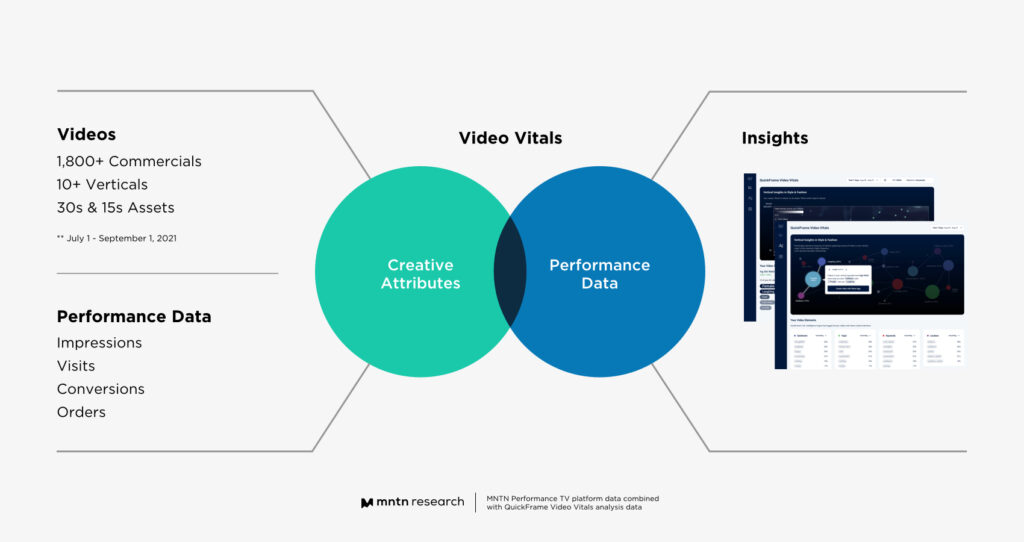
Key Definitions
Attributes
- Emotion: An analysis comprised of: (1) keywords present in voiceover; and (2) the sentiment/tone of the scene.
- Duration: The length or runtime of the video.
- Keyword: A specific word or phrase that is either spoken or appears on-screen as text.
- Object: A physical element that appears in a scene of the commercial.
- Scene: A single shot that is semantically and/or visually united.
- Sentiment/Tone: An overall interpretation of the tone based off of every element within a video (talent, voiceover, music, objects, etc.).
- Talent: A unique person identified within the video.
- Topic: A clustering of keywords and objects that are semantically and/or visually related.
Metrics
- Conversion Rate (CVR): The percentage of Verified Visits that resulted in a Conversion within the conversion window. Calculation: Total Conversions (divided by) Total Verified Visits.
- Visit Rate: The percentage of users that were served an impression that resulted in a Verified Visit. Calculation: Total Verified Visits (divided by) Users Reached.
Overall Insights
We examined the creative elements that make up each ad, from runtimes to the number of speaking roles, to determine which elements drove specific outcomes. The results are surprising, and can help inform overall creative approach when looking to launch a campaign with a specific goal in mind.
Attribute #1: Length/Duration
Analyzing both 15-second and 30-second videos, we found that the ideal run-time totally depends on your objective.
If optimizing for Visit Rate, 15-second ads drive 46% better performance than 30-second ads (and 36% better compared to the overall average Visit Rate). If your goal is conversions, however, a full 30-second ad is the optimal choice—driving 24% better performance against the overall average CVR.

Attribute #2: Sentiment/Tone
Reverse psychology may not be an advertiser’s friend on CTV. After analyzing the commercials’ tone of voice, we revealed that a negative tone results in the lowest performance across both Visit Rate and CVR metrics. Instead, advertisers saw stronger Visit and Conversion Rates by leaning into a positive or neutral tone of voice.
As the old saying goes, you catch more flies with honey, so don’t drag your campaign down with negative emotions. Instead, utilize a more optimistic or neutral tone to generate higher performance from your campaigns.
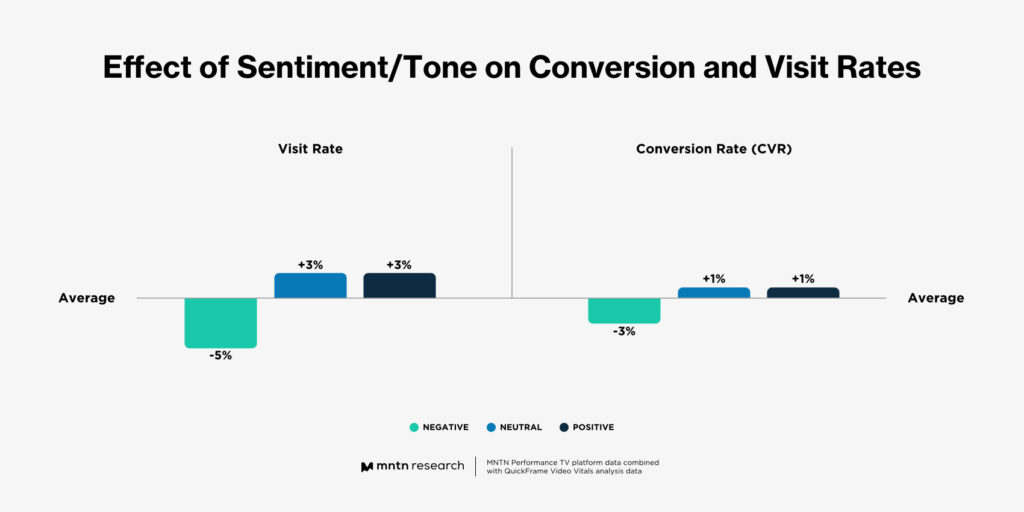
Attribute #3: Opening Emotion
How do you hook an audience’s attention and get them to take action? Open your commercial with a fear-based message, a highly effective emotion for driving website visits (49% better Visit Rate than the overall average). This approach, however, does result in 55% lower CVR than the overall average, so if your goal is conversions, steer clear of fear-based creative.
Instead, commercials that open with a lighter, more joyful message and tone drive a strong Visit Rate and a 7% higher CVR than the overall average.
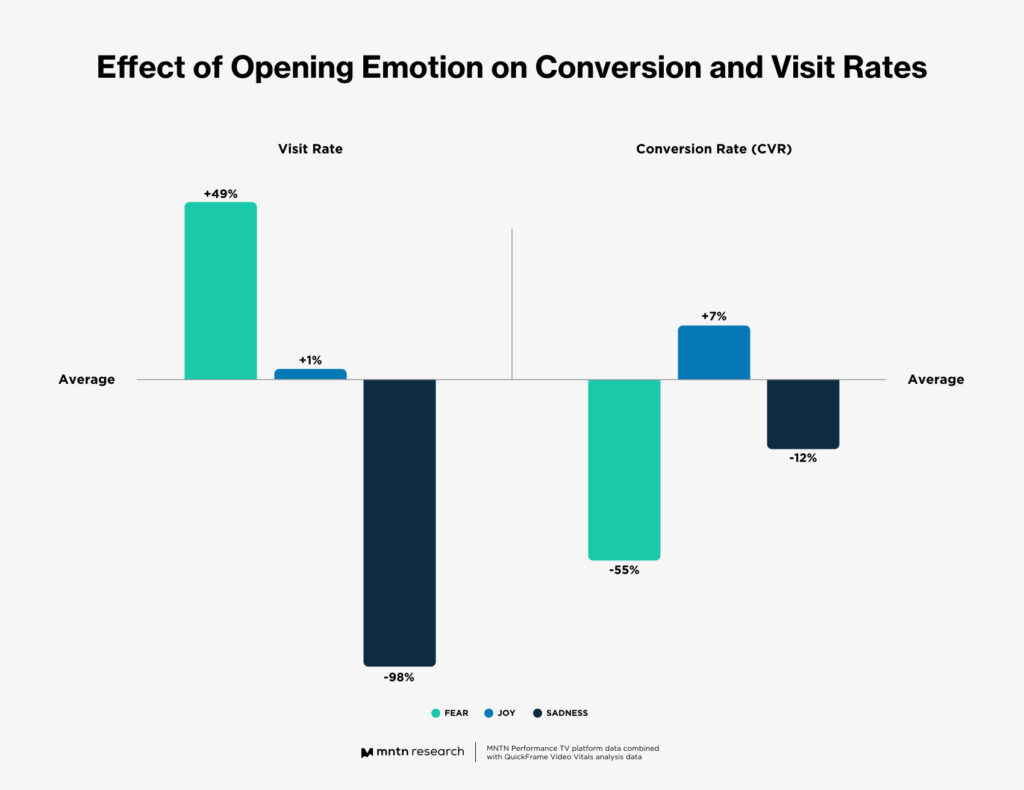
Attribute #4: Number of Talent
Casting talent that matches your brand aesthetic and voice is important, but how many people do you really need on set? The answer may surprise you.
When it comes to the optimal number of people to feature in your CTV commercials, more is more. Both 15 and 30-second commercials saw peak performance for both Visit and Conversion Rates when 6 or more talent were present throughout the creative.
Sound expensive? Not necessarily. Using UGC-style talent or real customers are cost effective ways to maximize your casting budget. In fact, not everyone in your cast needs to be expert orators.
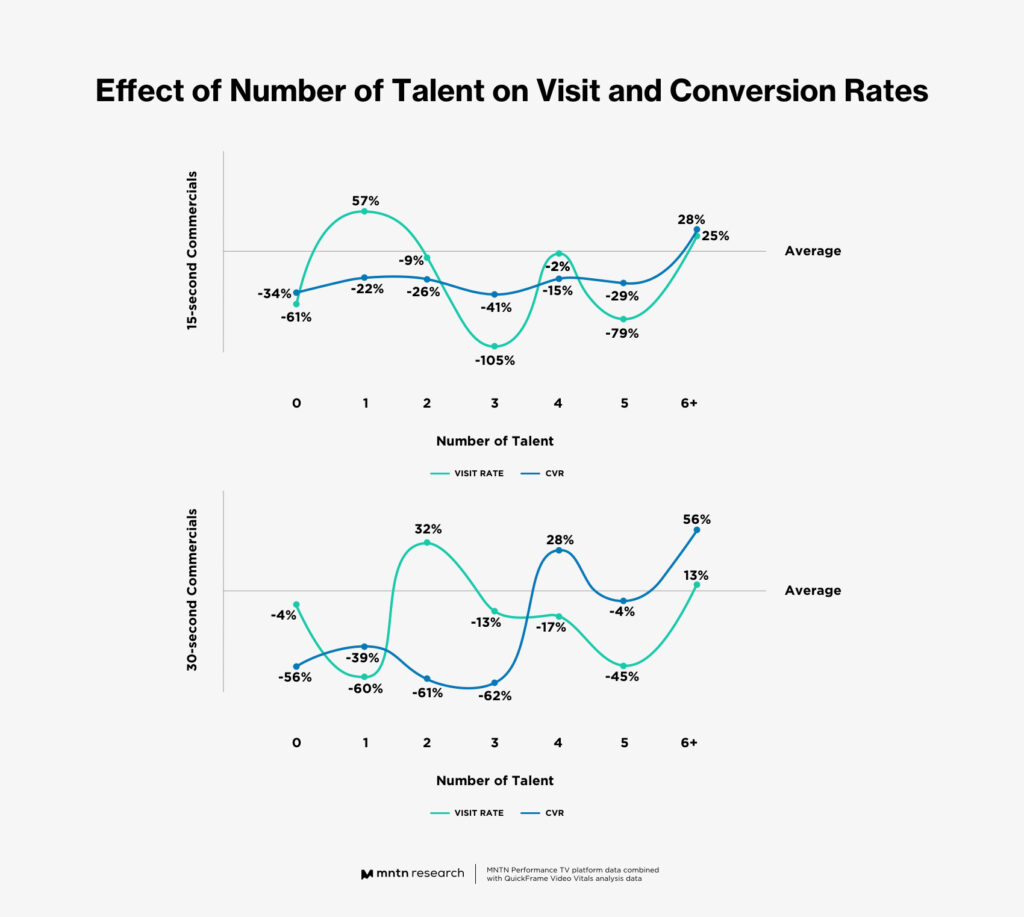
Attribute #5: Percentage of Talent Speaking
It’s clear that featuring multiple talent in a single ad leads to higher performance, but that doesn’t mean every character needs to have a speaking role. In fact, CTV commercials perform best for both Visit Rate and CVR when only around 50% of the on-screen talent have lines in a scene.
This means that, in addition to the actors you hire as lead characters or narrators, you’ll also want to cast a few non-speaking extras, which can really make your creative feel more authentic and realistic to your audience.
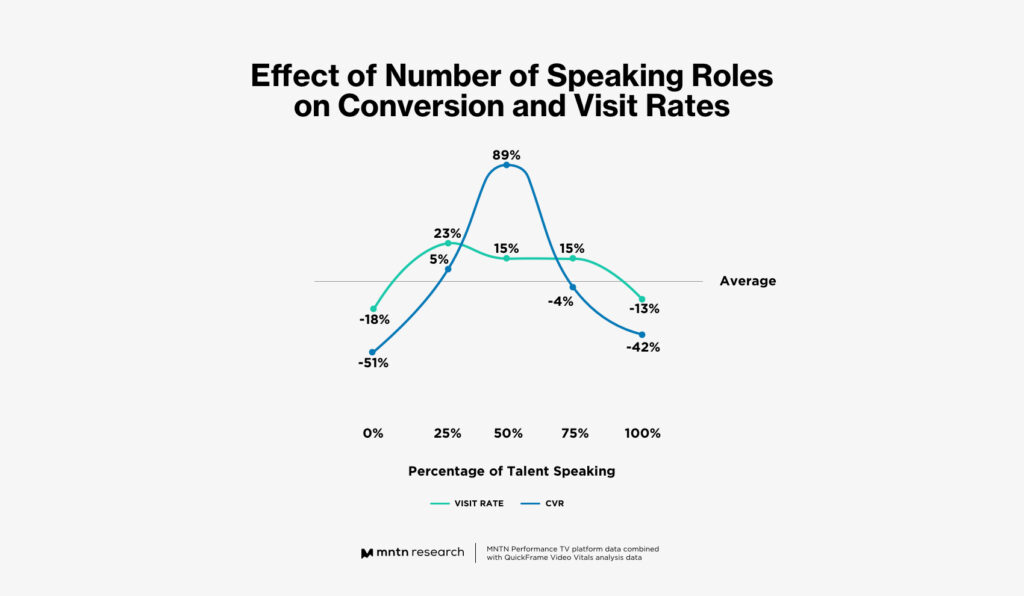
Attribute #6: Number of Scenes
Analyzing the optimal number of scenes to include in your CTV commercial reveals that audiences want dynamic ads with fast-cuts.
When concepting a 15-second commercial, aim to have 4 scenes (with 3 scenes driving the highest Visit Rate and 5+ scenes driving the highest CVR). Simple math suggests that each scene will only be 3-4 seconds long, so write your script accordingly.
The optimal number of scenes for 30-second commercials is similar to their 15-second counterparts. While you should plan for a similar number of fast-cuts, each scene can be longer, giving your narrative a little more room to breathe.
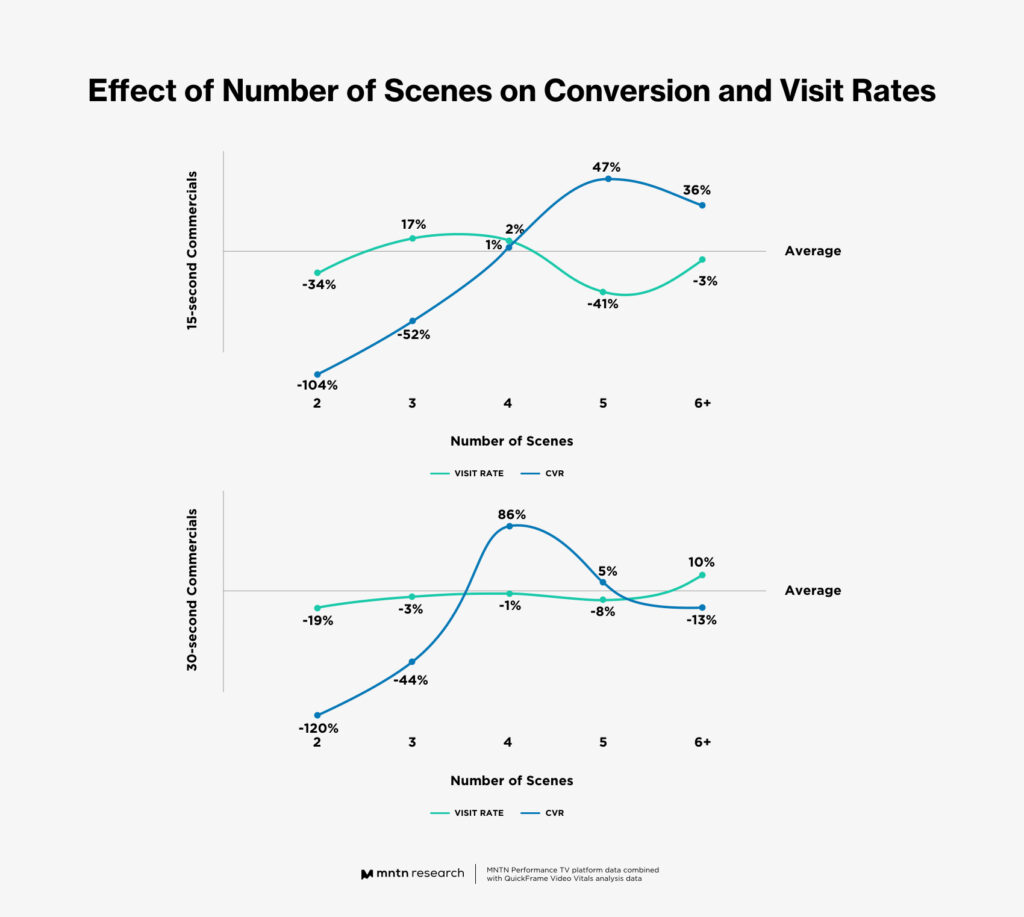
Vertical-Specific Insights
We analyzed specific verticals to understand which creative topics and narratives performed best—and worst—when compared to the overall average performance metrics.
Beauty & Wellness
Viewers responded well to anything related to aging, makeup professionals, and vitamin D. Not as popular? Gyms, shopping, and healthy living.
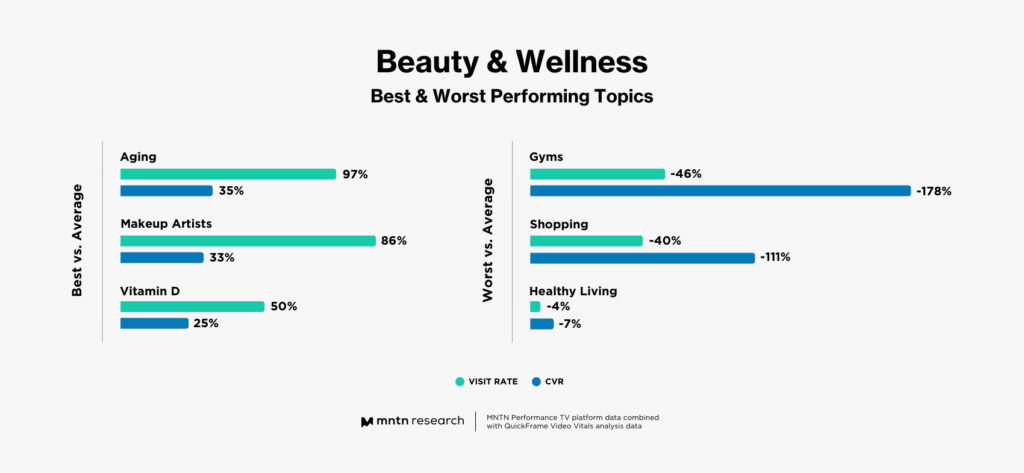
Fashion & Apparel
If you’re in the fashion world, you can’t go wrong with a 30 second ad. Those tended to perform well for both Visit and Conversion Rates (though if you’re interested in driving visits, 15 second ads were comparable for that goal).
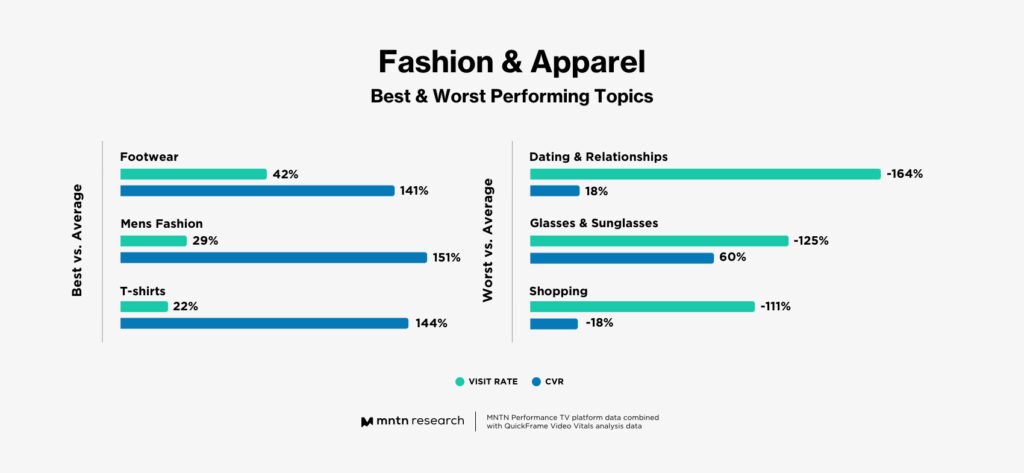
Food & Beverage
Ads with a 15 second runtime performed better for both Visit and Conversion Rate. Employing a positive tone was the best approach, which makes sense since we’re talking about food and drinks here.
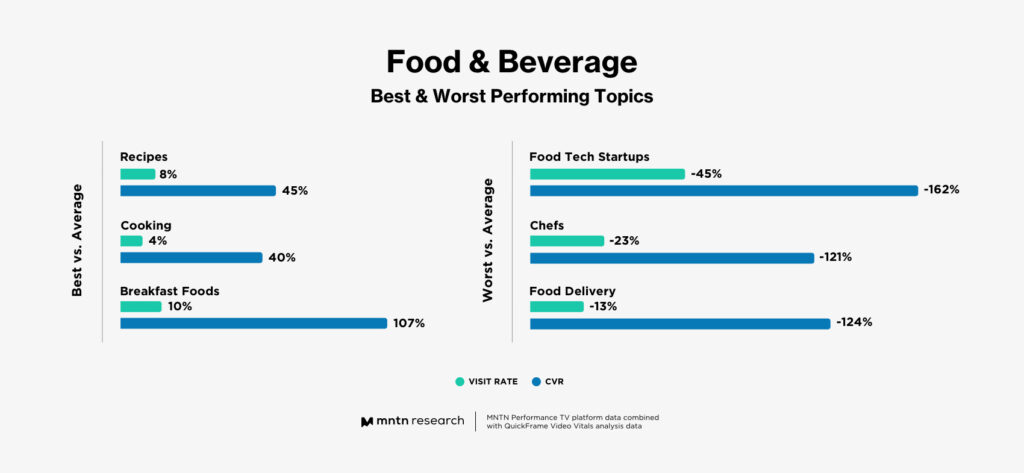
Home & Garden
The ideal length of these ads varied based on your goal; if you want to drive site visits, then a 15 second ad is best. If you’re interested in a stronger Conversion Rate, go with 30 seconds. And the more scenes the better. Both Visit and Conversion Rates were best when 6+ scenes were used.
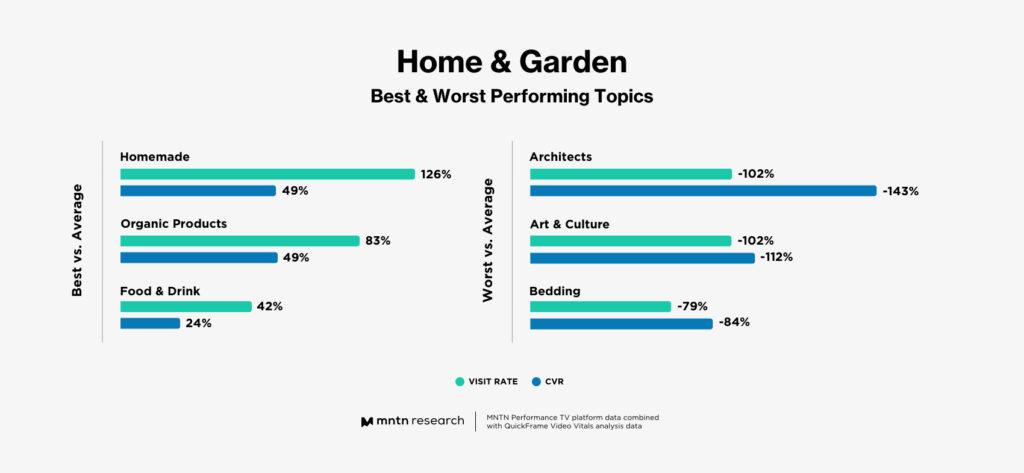
Travel
Travel viewers want to see more of the world, so it tracks that they also want to see more of your ad. The 30 second ad format was best for both Conversion and Visit Rates. Ads that featured visuals of the destination outperformed ads with a focus on talent, so keep those ads clear of tourists.
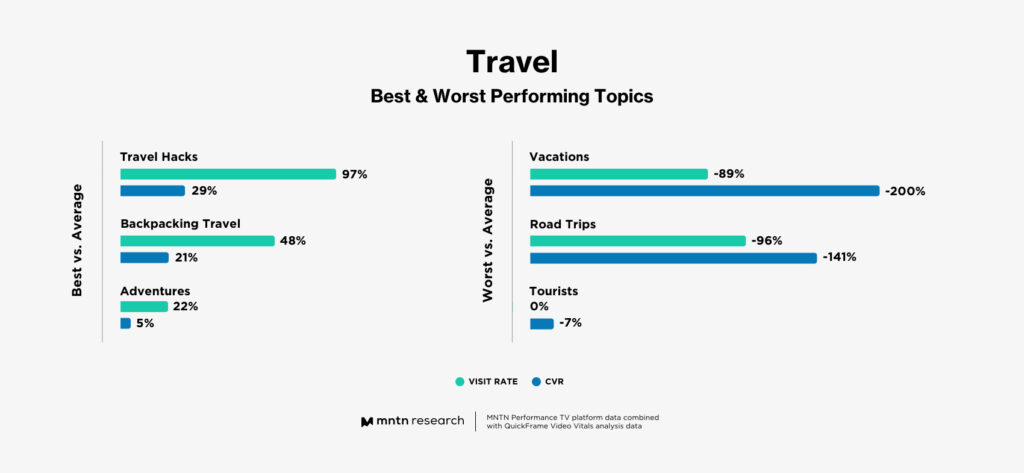
Conclusion
Different emotional triggers and elements in an advertisement can trigger different responses and outcomes in the target audience. Advertisers should keep emotion in mind when formulating a creative strategy; it is important to use elements in ad ad that align with the goals of the ad campaign.
Subscribe to the MNTN Research Weekly
Sign up to receive a weekly feed of curated research, sent straight to your inbox.